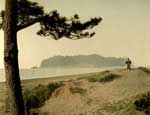
Beato; Bettoes Resting
c.1870
|

Beato; Japanese Woman
c.1870
|

Beato; Geisha with Fan
c.1870
|
|
The popularity of these hand-colored images was so great that
Beato hired Japanese artisans who traditional painted woodblock
prints to subtly color his photographs. This time consuming process
could take a meticulous painter as long as twelve hours to complete
two or three prints. Later this tedious procedure was modified to a
production line where several colorists each worked on a particular
area of the photographs: one artist colored the faces, then passed
it along to another who tinted the clothing. And so on increasing
the output to as many as twenty or thirty prints a day. |

von Stillfried; Geisha
c.1880 |
| Another important photographer of Meiji
Japan was Austrian-born Baron Raimund von Stillfried. Von Stillfried
was a painter who brought his European cultural and artistic
background to photography. His work was psychological in character
and offered a deeper insight into the lives and social classes of
the people he photographed. The photograph he made, primarily in the
studio, often incorporated plain backgrounds and a minimal number of
props. In 1872 he opened a photography studio in competition with
Beato's firm, and in 1877 von Stillfried purchased Beato's studio,
along with his glass plate negatives and equipment.
|

von Stillfried; Musician
c1880 |
| While in Japan, Baron von Stillfried
apprenticed Japanese assistants in his studio, many of whom later
went on to continue the photographic style established by the
Europeans. Kusakabe Kimbei was one of his special assistants who
had a great talent for the art of photography. He worked closely
with von Stillfried and in 1885 purchased most of his photographic
stock. He operated his own studio in Yokohama from 1885 to 1912,
where he produced portraits, scenes from daily life, and views of
Japan. Often Kimkei's photographs were like theatrical sets in
which he was the director. He selected the costumes, backgrounds
and props, then carefully positioned the "actor" to reflect the
polite social and religious ceremonies, rituals, and customs of the
Japanese people.
|

Kimbei; Shinto Priest
c.1885 |
| The photographs of Beato,
von Stillfried, Kimbei, and other photographers, many of who have
remained anonymous, resembled the Japanese woodblock prints in
content, style and coloring technique. Ukiyo-e prints, then the
most popular art of Japan, represented the superficial, earthly life
that passes quickly. The photographers of the Meiji period used the
subjects of the earlier printmakers as models for their photographs,
maintaining the Old World sensibilities of their Japanese customers
while at the same time satisfying the western demand for pictures of
classical Japan. They made portraits of Samurai warriors, street
musicians, and tattooed grooms, not as individual personalities, but
as stylized representations of social classes. They photographed
the serene beauty and landscape of the country showing Mt.Fuji, Lake
Hakone, simple teahouses and elaborate temples. The photographers
idealized old Japan and ignored its transformation from an insular,
medieval country to a modern land. This one -sided photographic
view gave outsiders the misleading impression that Japan was a
quaint, archaic nation well into the twentieth century.
|

Kimbei; Washing hands
c.1885 |

Kimbei; Girls showing Obi
c. 1885 |


